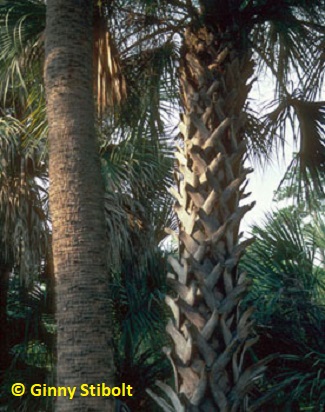
Trees and shrubs: the "Bones" of your landscape
by Ginny Stibolt
Trees and shrubs, the woody plants, provide the most
obvious structure, or the "bones," of the landscape. In Florida
we have hundreds of wonderful trees and shrubs from which to choose.
The most sustainable action is to preserve the appropriate existing
woody plants on your property and when selecting new trees and shrubs,
do as your extension agent would advise: "Select the right plant
for the right place." With proper selection and maintenance your
woody plants will provide shade, privacy, and habitat for wildlife.
They prevent erosion, cool their surroundings, and absorb carbon
dioxide from the air. That trees and shrubs also add beauty and
value to any landscape is a lovely bonus.
Evaluating existing trees and shrubs in the landscape
Evaluating existing woody plants in your landscape is
an important initial step in prudent and sustainable landscape design.
Preserving your existing trees, if they are in good health and growing
in appropriate locations, is smart. However, large trees that have been
weakened by disease, old age, injured roots, or physical restrictions,
such as sidewalks, foundations, or roads may need to be pruned or removed
before they do harm. Periodic evaluations of this kind help prepare
your landscape for hurricanes and other strong storms.
If you have a lot of trees and don't know where to start, seek professional
advice from a certified arborist who can help you develop a sound management
plan. An arborist may recommend pruning to relieve stress on the trunk.
It may take several years because no more than 20% of a tree should
be cut out in one year and topping is never a good option. Some of your
more dangerous and inappropriately placed trees may need to be removed,
but work to preserve as many woody plants in your landscape as you can.
Be sure to have the arborist identify all your trees and shrubs for
you. Note: Someone who cuts down trees is not necessarily a certified
arborist.
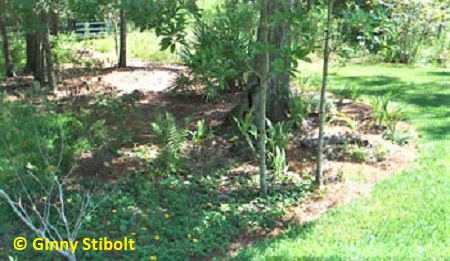 <<
Turf grass has been replaced with shade tolerant ferns, ground covers,
and shrubs under this grouping of trees. <<
Turf grass has been replaced with shade tolerant ferns, ground covers,
and shrubs under this grouping of trees.
Arranging your woody plants
Before you do any purchasing or planting, develop
a plan. Ideally you'd create a scale drawing of your lot and plan
out different sections to suit your purposes for each area, but
a quick sketch may work well for a simple landscape without too
much slope. Because some trees are adapted for growing in periodic
standing water and some are not, analyze stormwater drainage and
other water flows. Before you plant your new trees and shrubs, build
rain gardens and French drains that you need to handle most of the
stormwater most of the time.
Grouping compatible trees and shrubs together works best in the
landscape because this arrangement is most wind resistant and groups
of woody plants create good habitat for each other and for wildlife.
Your plan should consider prevailing winds, for wind shelter, especially
for seaside towns, since the constant onshore winds carry so much
salt. Try to imitate how Mother Nature would arrange those plants
and then mulch the whole area to create a low-maintenance grove.
Trees and lawns don't work well together-the
lawn will suffer because it's competing with shallow tree roots
for water, and later on the growing trees will provide too much
shade. The trees suffer abuse from lawnmowers and string trimmers
when they abut the lawn.
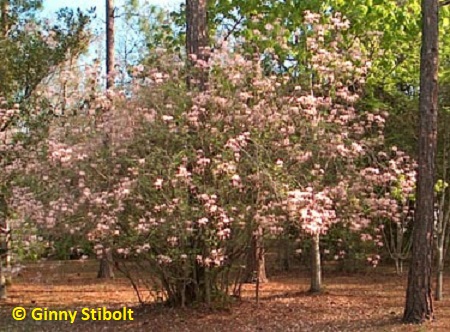 This native pinxster azalea (Rhododendron canescens) is a wonderful
understory addition to this piney landscape. This shrub is more than
10' tall and 20' wide. It has totally surrounded a pine trunk. Plan
ahead for adult sizes when planting trees and shrubs. >>
This native pinxster azalea (Rhododendron canescens) is a wonderful
understory addition to this piney landscape. This shrub is more than
10' tall and 20' wide. It has totally surrounded a pine trunk. Plan
ahead for adult sizes when planting trees and shrubs. >>
Choosing new trees and shrubs
When choosing the ideal trees and shrubs for your
landscape, plants native to your specific region are the best place
to start. Native plants have a well-developed tolerance for Florida's
soil, pests, salt air, and its wet and dry seasons. When considering
which trees and shrubs will fit into your landscape plans and think
years ahead about how much space the mature trees and shrubs will
require-vertically, horizontally, and add
30% to the horizontal growth to estimate the root mass.
When purchasing new trees and shrubs, it's best if you can select
your specimens from a reputable local nursery that can offer good
advice along with its well-cared-for plants. When choosing trees,
look for those with one main trunk or those that could be pruned
to a main trunk over a few years. For most species, a one-trunked
tree will look better in the long run, will be more wind resistant,
and require less corrective pruning. Look at the roots: they should
be firm and white, and they should not be circling within the pot
or rooted into the soil beneath the pot. In general, you'll want
a tree or shrub with healthy roots even if it's on the small side.
Look for new growth or buds and good green color on the older leaves.
The old advice was to choose the largest trees you could afford, but
smaller trees require less long-term care-especially irrigation. They
are more likely to survive and may even outgrow larger, more expensive
trees within a couple of years. (See the side bar below for irrigation
recommendations.)
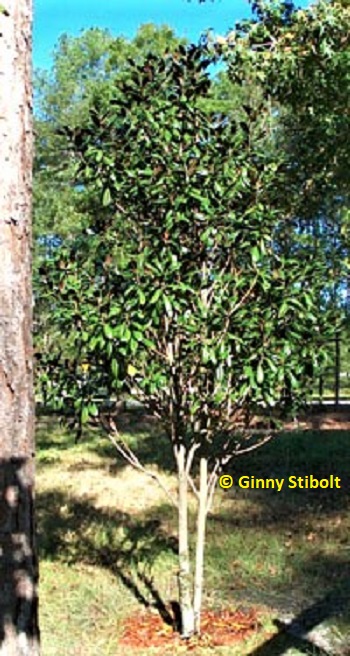 <<
This newly transplanted southern magnolia (Magnolia grandiflora)
has its mulched watering saucer. My husband and I transplanted this
tree five years ago (My magnificent messy magnolias)
and since it was the onset of a multi-year drought, I carried many watering
cans out to this front meadow over two years. Since its transplant,
it has grown at least 6 feet, maybe more. The other magnolia moved at
the same time has also done well. <<
This newly transplanted southern magnolia (Magnolia grandiflora)
has its mulched watering saucer. My husband and I transplanted this
tree five years ago (My magnificent messy magnolias)
and since it was the onset of a multi-year drought, I carried many watering
cans out to this front meadow over two years. Since its transplant,
it has grown at least 6 feet, maybe more. The other magnolia moved at
the same time has also done well.
Planting procedures
When planting a tree, dig a hole that is two inches
shallower than its root-ball or pot and at least twice as wide-wider
is better. Be sure that the center of the hole provides a solid
footing so the tree won't sink once it's in place. Most trees have
a slight flare where the roots start to spread; size your hole so
that this flare will be slightly above the soil line.
Before you remove the tree from its pot or wrap, set it in the hole
to check for placement. Prop it up if necessary, and then stand
back to view it from all angles-look up as
well. You don't want to plant trees directly under or near power
lines. Also, go inside and view it from your windows to make sure
that your planned location does not block a prized view. Again,
remember to consider its mature size.
Only after all this checking, remove it from its pot or wrap and
rinse away the old soil in the root-ball. As you place the root-ball
into the hole, stretch out its roots. Fill the hole with water as
you gently shovel the native soil back into the hole. No amendments
to the soil are recommended for trees or palms. It's been shown
that compost and other soil-enhancing materials added to the planting
hole can discourage the roots from spreading out into surrounding
soil. The exception is in a contained bed where roots can't spread
too far from the planting site-it this case,
enrich the whole bed with compost or other organic material. (See
my article on dealing with pot bound plants.)
After the hole has been filled in, press the soil gently in place
and create a shallow saucer equal to or larger than the size of
the root-ball by creating a berm of soil two or three inches high
around the circumference. Lay two to three inches of mulch over
this whole saucer area, but never up against the trunk.
If the tree is wobbly and could be knocked over by a gust of wind,
staking may be necessary until the roots start growing. Make sure
that no stakes enter the root-ball and that no wires or ropes abrade
the trunk. Except for palms, stake the tree in such a way that the
trunk can bend slightly in the wind-this will
enable the tree to build strength in its trunk. Remove the stabilizing
stakes as soon as possible, so the tree can build its own strength.
But newly transplanted palms should always be held in place firmly
for several months while they grow a whole new root system.
Irrigation Requirements after
Planting Trees
- Unless there is a soaking rain of one inch
or more in a week, these irrigation suggestions are over and
above general landscape irrigation.
- Each time you irrigate, it's best to water with three gallons
per inch of trunk caliper (the diameter of the trunk at six
inches above the root-ball of saplings). For example, use six
gallons for a two-inch caliper tree. Apply slowly, so all water
soaks into the root-ball.
- If a tree is two to four caliper inches, the best practice
is to water daily for one month and every other day for the
next three months. After that, water weekly until the tree is
established. For trees more than four caliper inches and for
palms, the best practice is to water daily for six weeks; every
other day for the next five months; and weekly after that until
the tree is established and new growth doesn't wilt during dry
periods.
- After the initial period, continue to supplement irrigation
for your tree during drought conditions for at least a year-two
or more years is better for larger specimens.
|
When your tree has been in the ground for at least three
months or just before its next growth period, you can, apply a topdressing
of compost or a light application of a slow-release, organic fertilizer
around, and outside of, the original planting hole to improve the soil.
Do not use fertilizer during a drought period, though,
because your new tree doesn't need the added stress of having
to support vigorous new growth when water is scarce. Wait for frond
growth on palms before applying compost or fertilizer.
Woody plants warrant extra care.
They'll reward you in many ways
Trees and shrubs are the most permanent and prominent landscape plants. Their proper care is a long-term investment. Time spent planning for and choosing the most appropriate trees and shrubs for your landscape, and handling them carefully, will mean greater survival rates, fewer problems, and less work in the long run. Plus growing more trees and shrubs increases the value of your property and is good for the planet.
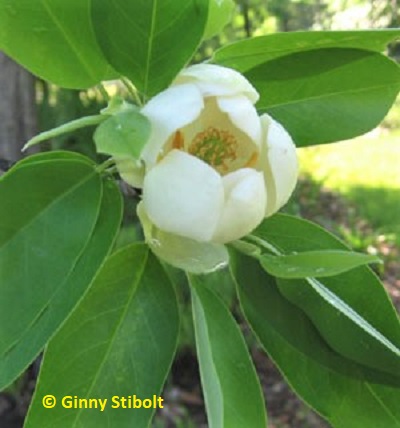 <<
Sweet bay magnolia (Magnolia virginiana) is a great choice for
your landscape here in northern Florida. It's a medium-sized tree with
leaves and flowers about one half the size of the southern magnolia
(M. grandiflora) and will form a thicket with its suckers, if
you let it. But one of the best characteristics of this native tree
in a wet year like this one is that it will survive in standing water. <<
Sweet bay magnolia (Magnolia virginiana) is a great choice for
your landscape here in northern Florida. It's a medium-sized tree with
leaves and flowers about one half the size of the southern magnolia
(M. grandiflora) and will form a thicket with its suckers, if
you let it. But one of the best characteristics of this native tree
in a wet year like this one is that it will survive in standing water.
Resources:
· Use the International Society of Arboriculture's website to search
for a certified arborist near you: www.isa-arbor.com.
· The website for the Florida Association of Native Nurseries provides
general information on native plants and has a locator for local member
nurseries: www.plantrealflorida.org.
· University of Florida professor maintain the Landscape Plants website,
with detailed information on tree establishment with irrigation details,
pruning and other care of woody plants: http://hort.ifas.ufl.edu/woody.
· Florida's
Best Native Landscape Plants by Gil Nelson has become a must-have
for Florida's gardeners and landscape designers.
|

 <<
Sweet bay magnolia (Magnolia virginiana) is a great choice for
your landscape here in northern Florida. It's a medium-sized tree with
leaves and flowers about one half the size of the southern magnolia
(M. grandiflora) and will form a thicket with its suckers, if
you let it. But one of the best characteristics of this native tree
in a wet year like this one is that it will survive in standing water.
<<
Sweet bay magnolia (Magnolia virginiana) is a great choice for
your landscape here in northern Florida. It's a medium-sized tree with
leaves and flowers about one half the size of the southern magnolia
(M. grandiflora) and will form a thicket with its suckers, if
you let it. But one of the best characteristics of this native tree
in a wet year like this one is that it will survive in standing water.

 <<
Turf grass has been replaced with shade tolerant ferns, ground covers,
and shrubs under this grouping of trees.
<<
Turf grass has been replaced with shade tolerant ferns, ground covers,
and shrubs under this grouping of trees. This native pinxster azalea (Rhododendron canescens) is a wonderful
understory addition to this piney landscape. This shrub is more than
10' tall and 20' wide. It has totally surrounded a pine trunk. Plan
ahead for adult sizes when planting trees and shrubs. >>
This native pinxster azalea (Rhododendron canescens) is a wonderful
understory addition to this piney landscape. This shrub is more than
10' tall and 20' wide. It has totally surrounded a pine trunk. Plan
ahead for adult sizes when planting trees and shrubs. >> <<
This newly transplanted southern magnolia (Magnolia grandiflora)
has its mulched watering saucer. My husband and I transplanted this
tree five years ago (
<<
This newly transplanted southern magnolia (Magnolia grandiflora)
has its mulched watering saucer. My husband and I transplanted this
tree five years ago (